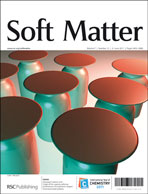A pH responsive system capable of forming a self-healing transient network across the pH 4.5 to 7.5 range is developed by increasing the ratio of phenylboronic acid (PBA) moieties to salicylhydroxamic acid (SHA) moieties incorporated in poly[N-2-hydroxypropyl]methacrylamide polymer backbones. We used particle tracking to assess network formation across the pH range of 4.5 to 7.5 with PBA : SHA stoichiometry of reactive groups of 1 : 1, 5 : 1 and 10 : 1. The 10 : 1 ratio of PBA : SHA forms a transient network across the entire pH range, while the 1 : 1 PBA : SHA materials demonstrate more liquid like behavior at pH 4.5 and forms a transient network only at neutral pH. At pH 7.5 increasing the ratio of PBA to SHA from 1 : 1 to either 5 : 1 or 10 : 1 increases the G′plateau sixty-fold, indicating that the higher probability of crosslink formation impacts the density of crosslinks compared to a 1 : 1 ratio of PBA to SHA. Above pH 5.5 the 5 : 1 and 10 : 1 PBA : SHA gels behaved similarly. Over the temperature range of 10 to 55 °C, the unequal stoichiometric ratios of 10 : 1 and 5 : 1 PBA : SHA transient networks behave similarly, with G′plateau dropping with a corresponding decrease in the characteristic relaxation time. Master curve analysis demonstrates superposition of the 1 : 1, 5 : 1 and 10 : 1 PBA : SHA stoichiometry except under the weakest network conditions (low pH, high temperature) suggesting that the same crosslinking mechanism dominates the network behaviour. The simple and complex viscosity is compared as a function of pH with shear thickening behaviour observed below pH 5.5. The 10 : 1 PBA : SHA crosslinked-network displays self-healing properties after repeated break cycles at both pH 4.5 and pH 7.5 demonstrating that increasing the ratio of PBA to SHA provides a material that can form a self-healing transient network at low pH, where the PBA–SHA crosslink association is weak, to neutral pH where the PBA–SHA complex is stabilized.

You have access to this article
 Please wait while we load your content...
Something went wrong. Try again?
Please wait while we load your content...
Something went wrong. Try again?


 Please wait while we load your content...
Please wait while we load your content...